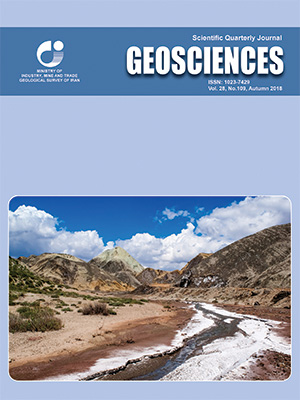References
Baranov, V., 1957- A new method for interpretation of aeromagnetic maps: pseudogravimetric anomalies. Geophysics 22, 359-383.
Billi, A., Filippis, L. D., Poncia, P., Pio Sella, P. and Faccenna, C., 2016- Hidden sinkholes and karst cavities in the travertine plateau of a highly-populated geothermal seismic territory (Tivoli, central Italy). Geomorphology 255 (2016) 63–80.
Branston, M. W. and Styles, P., 2006- Site characterization and assessment using the microgravity technique: a case history, Near Surface Geophysics, 4, p. 377-385.
Cardarelli, E., Cercato, M., Cerreto, A. and Di Filippo, G., 2010- Electrical resistivity and seismic refraction tomography to detect buried cavities: Geophysical Prospecting, v. 58, p. 685–695.
Chromčák, J., Grinč, M., Pánisová, J., Vajda, P. and Kubová, A., 2016- Validation of sensitivity and reliability of GPR and microgravity detection of underground cavities in complex urban settings: Test case of a cellar. Contributions to Geophysics and Geodesy. Volume 46, Issue 1, Pages 13-32.
Cooper, G. R. J. and Cowan, D. R., 2006- Enhancing poetential field data using filters based on the local phase. Computer and Geosciences, Vol. 32, pp. 1585-1591.
Dahlin, T. and Zhou, B., 2004- A numerical comparison of 2D resistivity imaging with 10 electrode arrays. Geophysical Prospecting 52, 379e398.
Ford, D. and Williams, P., 2007- Karst Hydrogeology and Geomorphology, John Wiley & son Ltd, England, pp. 1-562.
Gambetta, M., Armadillo, E., Carmisciano, C., Stefanelli, P., Cocchi, L. and Tontini, F. C., 2011- Determining geophysical properties of a near-surface cave through integrated microgravity vertical gradient and electrical resistivity tomography measurements: Journal of Cave and Karst Studies, v. 73, no. 1, p. 11–15.
Hanafy, S. M., Aboud, E. and Mesbah, H. S. A., 2010- Detection of subsurface faults with seismic and magnetic methods. Arab J Geosci DOI 10.1007/s12517-010-0255-6.
Jeng, Y., Lee, Y. L. Chen, C. Y. and Lin, M. J., 2003- Integrated signal enhancements in magnetic investigation in archaeology. J. Appl. Geophys. 53, 31–48.
Kaufmann, R, D. and DeHan, R. S., 2007- Microgravity Mapping of Karst Conduits within the Woodville Karst Plain of North Florida, Symposium on the Application of Geophysics to Engineering and Environmental Problems (SAGEEP ’07), Denver, Colorado, SAGEEP, Vol. 20, p. 1517-1526.
Khalil, M. H., 2016- Subsurface faults detection based onmagnetic anomalies investigation: A field example at Taba protectorate, South Sinai. Journal of Applied Geophysics 131 (2016) 123–132.
Loke, M. H. and Barker, R. D., 1996- Rapid least e square inversion of apparent resistivity pseudo e sections by a quasi enewton method. Geophysical Prospecting 44, 131e152.
Mathe´, V., Le´veˆque, F., Mathe´ P. E., Chevallier, C. and Pons, Y., 2006- Soil anomaly mapping using a caesium magnetometer: Limits in the low magnetic amplitude case. J Appl Geophys 58:202–217.
McDowell, P. W., 2002- Geophysics in Engineering Investigations. Geological Society Publishing House.
Mendonca, C. A. and Silva, B. C., 1993- A stable truncated series approximation of the reduction-to-the-pole operator. Geophysics 58, 1084–1090.
Miller, H. G. and Singh, V., 1994- Potential field tilt — a new concept for location of potential field sources. J. Appl. Geophys. 32 (2–3), 213–217.
Mochales, T., 2006- Prospeccio´n magne´tica aplicada a la deteccio´n y caracterizcio´n de dolinas en el entorno de Zaragoza. Unpublished MSc University of Zaragoza, 191 pp.
Orfanos, C. and Apostolopoulos, G., 2011- 2D–3D resistivity and microgravity measurements for the detection of an ancient tunnel in the Lavrion area, Greece. Near Surface Geophysics, 2011, 9, 449-457.
Orfanos, C. and Apostolopoulos, G., 2012- Analysis of different geophysical methods in the detection of an underground opening at a controlled test site. Journal of the Balkan Geophysican Society, Vol. 15, No. 1, March 2012, p. 7-18
Pesonen, L., Nevanlinna, H., Leion, M. A. H. and Ryno, J., 1994- The earth's magnetic field maps of 1990. Geophysics 30, 57–77.
Rybakov, M., Goldshmidt, V., Fleischer, L. and Rotstein, Y., 2001- Cave detection and 4-D monitoring: a microgravity case history near the Dead Sea. The Leading Edge (Society of Exploration Geophysicists) 20(8):896–900
Rybakov, M., Rotstein, Y., Shirman, B. and Al-Zoubi, A., 2005- Cave detection near the Dead Sea- a micromagnetic feasibility study. The Leading Edge (Society of Exploration Geophysicists) 24(6):585–590
Salem, A., Williams, S., Samson, E., Fairhead, D., Ravat, D. and Blakely, R. J., 2010- Sedimentary basins reconnaissance using the magnetic tilt-depth method. Explor. Geophys. 41, 198–209.
Sloan, S. D., Peterie, Sh. L., Miller, R. D., Ivanov, J., Schwenk , J. T. and McKenna, J. R., 2015- Detecting clandestine tunnels using near-surface seismic techniques. Geophysics, Vol. 80, NO. 5; P. EN127–EN135, 8 FIGS. 10.1190/GEO2014-0529.1
Vaziri, S. H. Majidifard, M. R. and Saidi, A., 2001- Geological map of Iran 1:100,000 sheet No. 6962, geological survey of Iran.
Zhou, W., Beck, B. F., Adams, A. L., 2002- Effective electrode array in mapping karst hazards in electrical resistivity tomography. Environmental Geology 42, 922-928.
Zieliński, A., Łyskowski, M. and Mazurkiewicz, E., 2016- Ground Penetrating Radar investigation of limestone karst objects in the Botanical Garden in Kielce. Geology, geophysics & Envirnoment. vol. 42 (1): 31–38.

